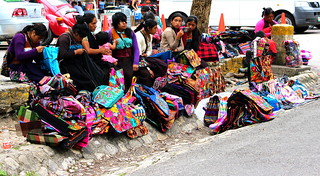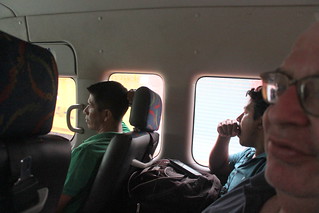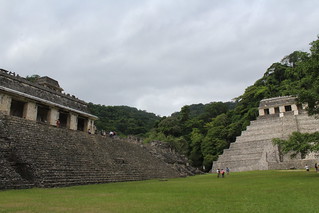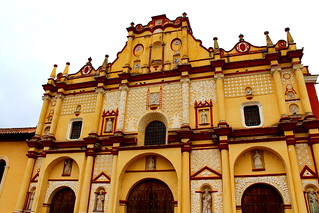Like many people, before visiting there; one of the first things that would come to mind when we would hear the word “Chiapas” was the Zapatista rebellion begun in 1994 and the leader of that group, Subcomandante Marcos.
We won’t delve too deeply into the rights and wrongs of that revolution but it is  hard to argue the fact that it stemmed from the oppression of the indigenous peoples in this, one of the poorest regions in Mexico. While many of the promises made by the government in the peace settlement have gone unfulfilled, some changes have been implemented and despite the occasional isolated event; the area is now peaceful and safe to visit. For some travelers, their concern about the Zapatista was reason enough not to visit Chiapas. But for many others, the region holds strong attractions and now is one of the most popular vacation destinations for Mexican Nationals.
hard to argue the fact that it stemmed from the oppression of the indigenous peoples in this, one of the poorest regions in Mexico. While many of the promises made by the government in the peace settlement have gone unfulfilled, some changes have been implemented and despite the occasional isolated event; the area is now peaceful and safe to visit. For some travelers, their concern about the Zapatista was reason enough not to visit Chiapas. But for many others, the region holds strong attractions and now is one of the most popular vacation destinations for Mexican Nationals.
Chiapas is not the easiest place in Mexico to get to but that does add somewhat to its charm. The quickest way to go is to fly into Tuxtla Gutiérrez, the nearest airport that is a regular daily 
destination of commercial airlines. From there you can rent a car, take a bus or hire a cab to head in any direction you choose (i.e. San Cristobal, Palenque, etc.). As an alternative, you can take an overnight bus from Cancun, Playa del Carmen or other points on the east coast, from Merida near the Gulf coast or from Oaxaca City to the west.
Our trip there began in Cozumel so we took a ferry over to Playa del Carmen and headed out of town on an ADO GL in the early evening. A few stops and 11 hours later we pulled into the bus station in Palanque. After a night there, we took a 5-hour bus ride or more correctly a 5 hour ride in a combi mini-van to San Cristobal. More on that part of our trip is in the Palenque section. On our return, we hired a car and driver for a ride to the airport to catch a flight from Tuxtla Gutiérrez to Cancun.
The Mayan ruins of Palenque are generally considered the top attraction in Chiapas  for many. Historians tell us the beginning of the city-state was around 200 A.D. but most of what has been restored and what is known about life in ancient Palenque is from the Classic period dating from 600-900 A.D. While not a large city, Palenque offers visitors a chance to get a close up look at some stunning architecture and learn the story of the Maya of this region and its most famous ruler; Pakal the Great.
for many. Historians tell us the beginning of the city-state was around 200 A.D. but most of what has been restored and what is known about life in ancient Palenque is from the Classic period dating from 600-900 A.D. While not a large city, Palenque offers visitors a chance to get a close up look at some stunning architecture and learn the story of the Maya of this region and its most famous ruler; Pakal the Great.
Our desire to see Palenque was the reason we took the overnight bus rather than flying round trip but in all honesty, the main draw for our visit was the tradition of hand weaving textiles on “back-strap” looms; a tradition that dates almost as far back as the beginning of Palenque and that continues to  flourish today. On these pages you can read our reports of visits with weavers in indigenous communities of Tenejapa, San Andrés Larráinzar, San Juan Chamula and San Lorenzo Zinacantán; all near San Cristobal.
flourish today. On these pages you can read our reports of visits with weavers in indigenous communities of Tenejapa, San Andrés Larráinzar, San Juan Chamula and San Lorenzo Zinacantán; all near San Cristobal.
While many of the indigenous weavers of the region continue to use the ancient patterns; others like the famous master weaver María Meza Girón of Tenejapa are now putting their own mark on the craft creating new designs, techniques and traditions. One of the fascinating aspects to the weaving in the region is that each little village will have its own colors or materials or patterns and that favored designs are still evolving.
Our only exposure to another great attraction in Chiapas was driving on a bridge across a deep gorge on our way to the airport in Tuxtla Gutiérrez but on our next visit there, we plan to do a boat trip on the Grijalva River through the Sumidero Canyon (Cañón del Sumidero). Editors Note: In a subsequent visit to Chiapas we did make it to the Sumidero Canyon and a report can be seen at the link.
 If all that is not enough; a chance to visit the stunning colonial city of San Cristóbal de las Casas is reason enough to visit Chiapas. This beautiful city features a compact historical center with gorgeous period architecture, excellent restaurants, a lively music scene, reasonably priced accommodations, great shopping and perhaps best of all, a friendly hospitable local citizenry.
If all that is not enough; a chance to visit the stunning colonial city of San Cristóbal de las Casas is reason enough to visit Chiapas. This beautiful city features a compact historical center with gorgeous period architecture, excellent restaurants, a lively music scene, reasonably priced accommodations, great shopping and perhaps best of all, a friendly hospitable local citizenry.
We really only scratched the surface on our week long trip to Chiapas but plans are already being made for our return.
